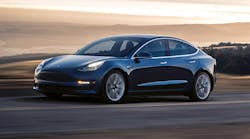Tesla Inc. is making its debut in the primary corporate bond market as Elon Musk bolsters his company’s audacious bet on a more affordable electric car.
The automaker plans to offer $1.5 billion in senior unsecured notes due in 2025, according to a statement. The proceeds will be used to help Tesla bring out the Model 3, its cheapest model yet, and for general corporate purposes.
The debt sale will test Musk’s ability replicate the fervent following he’s built among stock investors, who’ve bought into his vision of a clean-energy future and pushed the shares up 67% this year. While bond markets have been running at historically frothy levels, Tesla is asking potential noteholders to overlook the company’s negative cash flow and its repeated trips to capital markets to cover losses.
This would be the company’s first sale of non-convertible bonds, according to data compiled by Bloomberg. During early conversations with investors, Tesla has been offering to pay around 5% on the notes, according to two people with knowledge of the matter, who asked not to be identified as the discussions are private. That lines up with the 5.4% investors are demanding for junk-rated companies, according to Bloomberg Barclays index data.
“As a straight bond investor, it’s hard for me to think I really want to do this,” said Jack Flaherty, a money manager at GAM Holding AG who previously bought Tesla convertible debt. The convertibles give holders a chance to profit if Tesla succeeds, by letting them swap the bonds for stock.
But prospective investors in this deal will just get the yield -- and perhaps not enough to compensate for the risk, Flaherty said. “It’s not like we’re getting 10 percent to fund a negative-cash-flow company,” said Flaherty, who hasn’t decided if he’ll participate.
Mass Market
The $35,000 Model 3 is the linchpin of Musk’s plans to turn Tesla into more of a mass-market manufacturer. With a starting price roughly half the cost of the base Model S, the smaller sedan has racked up almost half a million net reservations since the company began taking refundable deposits last year. The carmaker plans to make 500,000 vehicles in 2018 and a million in 2020. The company produced almost 84,000 cars and sport utility vehicles last year.
Investor enthusiasm has catapulted Tesla’s market value past General Motors Co. and Ford Motor Co., but bringing out the Model 3 has been costly. Tesla burned through a record $1.16 billion in cash in the second quarter, driven by spending on production capacity for the car and batteries.
Musk said on a quarterly earnings conference call last week that the company was considering raising debt, but not equity. Tesla has been able to negotiate favorable payment terms with suppliers to the Model 3, which should help improve cash flow.
“The Nirvana is that we can make the car and get paid for the car before we have to pay our suppliers, which then the faster you grow, the faster your cash position grows,” Musk said Wednesday. “Obviously, that’s like the promised land right there.”
The bond sale is the latest in a series of moves Tesla made to pad its coffers this year. The company raised about $1.4 billion in March through a stock and debt offering and in June expanded credit agreements by a combined $800 million.
“There is a well-developed track record of successful investments and generating returns on those investments,” said James Albertine, a senior analyst at Consumer Edge Research who has a buy rating on Tesla shares. “Tesla’s a company that’s always on to the next big innovation or the next big advancement and they raise money well in advance of when the public finds out about that.”
Tesla ended the second quarter with a little more than $3 billion in cash, the lowest on hand in more than a year. The carmaker said last week it expects about $2 billion in capital expenditures in the second half of the year as it spends on Model 3 equipment, its battery gigafactory and the expansion of its supercharger network.
To accommodate its expanding customer base, Tesla has said it plans to add 100 service centers worldwide over the next year and hire 1,400 technicians to work on its cars. Musk plans to add a semi truck to the lineup after the Model 3 and has said that will be unveiled in September. After that comes the Model Y, a smaller crossover scheduled to arrive as soon as late 2019.
Tesla recently started installing solar roofs and is pairing that business with sales of Powerwall batteries that can store that energy and power homes. It’s also doing business with municipalities, with Musk planning to build the world’s biggest battery to support South Australia’s blackout-plagued power grid.
By Molly Smith and Gabrielle Coppola



